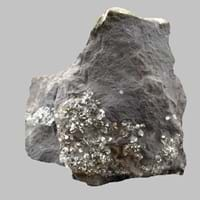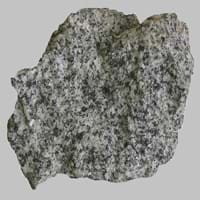Argillite and Diorite
Definition
Definition
Argillites are highly compact sedimentary or slightly metamorphosed rocks that consist largely or wholly of particles of clay or silt but lack the fissility of shale or the cleavage characteristic of slate
Diorite is a grey to dark-grey intermediate intrusive igneous rock composed principally of plagioclase feldspar,biotite, hornblende, and pyroxene
History
Discoverer
Unknown
Unknown
Etymology
From Latin Argilla (clay) and -ite in English which became agrilla+ -ite = Argillite
From early 19th century coined in French, formed irregularly from Greek diorizein distinguish
Class
Sedimentary Rocks
Igneous Rocks
Sub-Class
Durable Rock, Soft Rock
Durable Rock, Hard Rock
Family
Group
Not Applicable
Plutonic
Other Categories
Fine Grained Rock, Opaque Rock
Coarse Grained Rock, Medium Grained Rock, Opaque Rock
Texture
Texture
Clastic, Polished
Phaneritic
Color
Dark Grey to Black, Pink, Red, White
Black, Brown, Light to Dark Grey, White
Maintenance
Less
Less
Durability
Durable
Durable
Water Resistant
No
No
Scratch Resistant
Yes
No
Stain Resistant
Yes
No
Wind Resistant
Yes
Yes
Acid Resistant
Yes
No
Appearance
Rough and Dull
Shiny
Uses
Architecture
Interior Uses
Decorative Aggregates, Homes, Interior Decoration
Decorative Aggregates, Interior Decoration
Exterior Uses
As Building Stone, Garden Decoration, Office Buildings
As Building Stone, As Facing Stone, Garden Decoration
Other Architectural Uses
Curbing, Whetstones
Curbing
Industry
Construction Industry
Used for flooring, stair treads, borders and window sills.
As Dimension Stone, Cement Manufacture, Cobblestones, Construction Aggregate, for Road Aggregate
Medical Industry
Not Yet Used
Not Yet Used
Antiquity Uses
Artifacts, Monuments, Sculpture
Artifacts, Monuments, Sculpture, Small Figurines
Other Uses
Commercial Uses
Fire resistant, Used to manufracture paperweights and bookends
Creating Artwork, Curling
Types
Types
Not Available
Not Available
Features
Is one of the oldest rock
Typically speckled black and white.
Archaeological Significance
Monuments
Used
Used
Famous Monuments
Data Not Available
Data Not Available
Sculpture
Used
Used
Famous Sculptures
Data Not Available
Data Not Available
Pictographs
Used
Not Used
Petroglyphs
Used
Not Used
Figurines
Used
Used
Fossils
Present
Absent
Formation
Formation
An argillite is a fine-grained sedimentary rock mainly composed of clay particles which forms from lithified muds which contain variable amounts of silt-sized particles.
Diorite is a coarse-grained intrusive igneous rock which contains large interlocking and randomly oriented crystals and forms when molten lava does not reach the Earth’s surface and cools down in the Earth’s crust.
Composition
Mineral Content
Biotite, Chlorite, Feldspar, Micas, Muscovite or Illite, Plagioclase, Pyrite, Quartz
Albite, Amphibole, Apatite, Biotite, Feldspar, Hornblade, Ilmenite, Magnetite, Muscovite or Illite, Olivine, Plagioclase, Pyroxene, Quartz, Sulfides, Titanite, Zircon
Compound Content
Iron(III) Oxide, Potassium Oxide, MgO, Silicon Dioxide
Silicon Dioxide
Transformation
Metamorphism
No
Yes
Types of Metamorphism
Not Applicable
Cataclastic Metamorphism, Contact Metamorphism, Regional Metamorphism
Weathering
Yes
Yes
Types of Weathering
Biological Weathering
Biological Weathering, Chemical Weathering, Mechanical Weathering
Erosion
Yes
Yes
Types of Erosion
Chemical Erosion
Chemical Erosion, Coastal Erosion, Water Erosion
Properties
Physical Properties
Hardness
2-3
6-7
Grain Size
Fine Grained
Medium to Coarse Grained
Fracture
Conchoidal to Uneven
Not Available
Streak
White to Grey
Bluish Black
Porosity
Highly Porous
Very Less Porous
Luster
Waxy and Dull
Shiny
Compressive Strength
Not Available
225.00 N/mm2
7
Cleavage
Slaty
Not Available
Toughness
2.6
2.1
Specific Gravity
2.56-2.68
2.8-3
Transparency
Opaque
Opaque
Density
2.54-2.66 g/cm3
2.8-3 g/cm3
Thermal Properties
Specific Heat Capacity
0.87 kJ/Kg K
14
Not Available
Resistance
Heat Resistant, Impact Resistant
Heat Resistant, Pressure Resistant, Wear Resistant
Reserves
Deposits in Eastern Continents
Asia
Bangladesh, China, India, Russia
Not Yet Found
Africa
Ethiopia, Kenya, Morocco, South Africa, Tanzania
Egypt
Europe
Austria, France, Germany, Greece, Italy, Romania, Scotland, Spain, Switzerland
Finland, Germany, Italy, Romania, Sweden, Turkey, United Kingdom
Others
Not Yet Found
Not Yet Found
Deposits in Western Continents
North America
USA
USA
South America
Bolivia, Chile, Colombia, Ecuador, Peru, Venezuela
Argentina, Bolivia, Chile, Colombia, Ecuador, Peru
Deposits in Oceania Continent
Australia
New South Wales, New Zealand, Queensland, Victoria, Western Australia
New Zealand, Western Australia
All about Argillite and Diorite Properties
Know all about Argillite and Diorite properties here. All properties of rocks are important as they define the type of rock and its application. Argillite belongs to Sedimentary Rocks while Diorite belongs to Igneous Rocks.Texture of Argillite is Clastic, Polished whereas that of Diorite is Phaneritic. Argillite appears Rough and Dull and Diorite appears Shiny. The luster of Argillite is waxy and dull while that of Diorite is shiny. Argillite is available in dark grey to black, pink, red, white colors whereas Diorite is available in black, brown, light to dark grey, white colors. The commercial uses of Argillite are fire resistant, used to manufracture paperweights and bookends and that of Diorite are creating artwork, curling.
|
||
|
||
|










